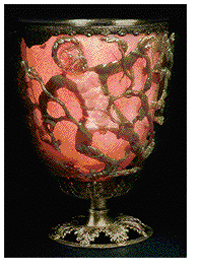|
The Lycurgus Cup
Nanoscience/nanotech is a hot research topic these days, in fact red hot,
and it should really be called Red Sunset Hot. Why? Well, let’s see …
We have all seen orange red-sunsets, red-sunrises, the midday yellow sun,
and the blue sky. We have all been taught at Pui-Ching why these things have
specific colors.
Here is a photo of sunset at Newport Beach, CA one December day, and the
orange-red color is obvious. Do you still remember why it looks the way it
looks?

We learned at Pui-Ching that sunlight is scattered and only gives off
red/orange color when the sun is near the horizon, Remember? Well, what we
did not learn was that nano-size particles in the atmosphere scatter away
most of the other colors with high frequencies, and only red and orange
colors with low frequencies reach our eyes, or in the lens of the camera.
The scientific term for this selective scattering is called “Rayleigh
Scattering”, the intensity of which depends on the particle size, frequency
of the photons, and the angle of scattering and the refractive index of the
particle.
All these mumbo-jumbos are to say that nano-size related phenomena and
science have been around since time began, not to mention all the
single-cell and/or simple bacteria are “nano” in size. In this case it means
nanometer in size, or 10-9 meters. You may say, hey, no fair! This is a
natural phenomenon. True, air (O2 and N2) molecules are natural light
scatterers, but industrial pollutants, smog particles, smoke and the like
are not.
Let us fast forward from the beginning of time to the 4th century. It was
Roman time, and we have here the Lycurgus cup (after King Lycurgus), a glass
cup housed in the British Museum. The cup appears green when it is
illuminated from the outside. When it is illuminated from the inside, it
glows red.
 
It turns out that the red color is due to very small of gold/silver alloy
powder (~70 nanometer, nm, in size. Nano = 10-9 .) mixed into the glass.
Bacteria are about 100 times bigger than these particles. When light passes
through the glass, it is again scattered, and this is time it is due to the
“Mie scattering”, which becomes important when the particle size is smaller
than the wavelength of interest, but not as small as gas molecules or atoms.
Certain colors (different wavelengths) of the light are absorbed as light
strikes the particles, as a result of something call “ surface plasmon
resonance”, SPR.
Surface plasmon is the collective oscillation wave of the free electron gas
in the particle, and the oscillation frequency is size and refractive index
dependent. It so happens that the Au particles of ~70 nm in size absorb most
of the other colors (absorption peak around 520 nm), and only red light
passes through the cup, therefore, the cup appears red. In Roman time, they
knew how to make these fine Au particles, which are tough to make to be
uniform in size. One cannot see them with naked eyes. Grinding Au coins
would not yield nano-size Au powders readily.
So it appears that nanotech has been around for a long long time.
Here is another example of color glass in England, “Labors of the Months”
Norwich, England, ca. 1480. The ruby color is probably due to embedded gold
nanoparticles.

What good are these metal nanoparticles other than giving colors to glass
and whatnots? One of the interesting applications is to use these particles
as sensors to detect DNA and other bio-related materials. The way it works
is when DNA strands are attached onto these particles, the refractive index
of the particle changes, and so thus the surface plasmon resonance
frequency, and the color of the colloid.
Here we have a gold color colloid with fine Au powder before DNA strands are
linked to the Au particle. After attaching DNA strands, the resonance
frequency changes, and the color turns blue. In this way, nano-particles
serve as sensors to detect, say, very very small biological matters by just
looking at the color of the colloid (see the following figure).

Schematic of DNA linked to Au nanoparticles, causing the frequency of SPR to
shift, and the coloration.
So is nanotechnology going to lead to a new industrial revolution? I don’t
know, only time can tell.
I can say that when Professor Rabi at Columbia University predicted and
observed nuclear magnetic resonance, NMR, in 1937, it was perhaps purely for
the interest of physics. He did not know the impact that was to come in
clinical medicine as one of the most powerful medical diagnostic tools.
|


![]()
![]() Get
your own Free Home Page
Get
your own Free Home Page